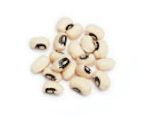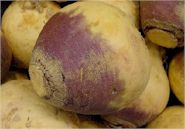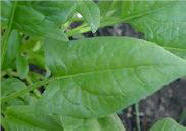|
|
|
 |
Parsnips
Select firm, unshriveled
parsnips of moderate size (large ones can be woody). The
outside should be relatively clean and free of surface
blemishes. Avoid those that are limp, shriveled, or
spotted.
Parsnips will store well for several weeks in plastic
packaging in the refrigerator's vegetable crisper.
Parsnips are sweet and look a bit like yellow carrots.
Before using Parsnips, rinse well, trim the crown and
peel the |
|
outer skin. Parsnips are
often dipped in wax to retard growth during storage, be
sure to remove all the wax.
Parsnip has a flavor described as nutty, spicy or
peppery. It's well suited to
prolonged cooking, as in casseroles and stews, or
oven-roasted on its own. Parsnip patties are a southern
favorite. |
|
 |
Peas
Peas grown for the immature
peas are called garden peas, shell peas or green peas.
They are sold fresh (usually in the pod), or tinned or
frozen.
Look for plump, bright green pods.
Fresh peas are often eaten boiled and flavored
|
|
with butter and/or spearmint as a
side dish vegetable. Fresh peas are also used in pot
pies, salads and casseroles. Pod peas (particularly
sweet varieties, like sugar peas) are used in stir fried
dishes. Peas should be used shortly after
harvest as they loose their
flavor. |
|
 |
Cow Peas
There are many members of
the "cow pea" or "southern pea" family, black-eyed peas,
purple hull peas, zipper peas and crowder peas.
The seeds eye actually has color, such as black, brown,
tan, pink, and so on. Some varieties of seeds have body
color also such as, black, tan, blue, gray, speckled and
|
|
purple to name a few. Cook as you
would for dry beans. Sort through the peas and discard
pieces of dirt or stones.
According to tradition you are to eat your black-eyed
peas on New Years Day and most likely they'll be from
the south. Oh, and toss a few dried ones in with your
coin purse on that day and make sure you eat greens with
those black-eyed peas. The peas bring good luck and
stand for copper and gold coins and the
greens stand for folding money so goes the
superstition. |
|
 |
Peppers
The color can be green, red, yellow, orange and, more
rarely, white, purple and brown depending on when they
are harvested. Specifically, green peppers are unripened
bell peppers. They are eaten green or ripe and are used
for salads, stuffing, soup, stews, relishes and
pickling.
Choose dark green, well
developed, bell shaped |
|
peppers with no soft
spots or bruises. Store in crisper until ready to use,
approximately 1 week.
Hot pepper varieties have also enjoyed a rebirth of
popularity recently, mainly due to various ethnic
cuisines that use their unique flavors and heat
creatively. |
|
 |
Potato
Unless you buy your potatoes
from a farmer it is often hard to see inside the bag of
potatoes at the store. If you notice an order where the
potatoes are stacked, look carefully at the bag for
rotting potatoes.
Potatoes' skins come in the
colors brown, yellow, |
|
pink, red, and purple. Their
flesh may appear white or may reflect the color of the
skin. Blue potatoes are white when cooked.
In the market "fingerlings" or "new" potatoes, larger
potatoes may class as "earlies" or "main crop", with the
"main crop" referring to varieties that will store well.
The Potato bag may contain information as to type:
"boiling", indicating that they retain some shape when
boiled
"baking", indicating that they only hold their shape if
baked
"roasting", indicating good flavor when roasted
"salad" to indicate suitability for salad use
"mashing" to indicate that when mashed they form a
smooth consistency, neither fibrous
nor grainy |
|
 |
Pumpkin
Pumpkins arrive in the
stores in early fall, just in time for Halloween.
Pumpkin are a member of the squash family and can be
prepared in the same manner.
In choosing pumpkin for pies
pick the medium sized ones. Watch for bruises,
nicks and softness. Your pumpkin should be firm
and with an inch of the vine
attached. |
|
 |
Radish
When selecting radishes,
choose the ones with the tops removed. The leaves
cause moisture to be lost during storage. Refrigerate
radishes in plastic bag and store in the crisper for 5
to 7 days.
Trim the tops and root and
slice for use in salads or
grate them as an addition to
coleslaw. |
|
I have been told that sliced
radishes can be added to
spaghetti like mushrooms! |
|
 |
Rutabaga
Rutabaga s should be four to
six inches in diameter and free of bruises and
blemishes. Shriveled roots are a sign of age and should
not be used. They are often waxed for storage purposes.
Wash and peel, making sure to remove any wax. Cube the
rutabaga to use in soup or
casseroles. |
|
 |
Spinach
Fresh spinach is available
year round, sold in bags or loose. When choosing
spinach select small leaves, with a good green color.
Stems should be thin or the spinach will be tough.
Spinach is grown in sand and
needs special care in |
|
washing to remove the grit
of the sand. Often you will need to wash each leaf
individually. Wash spinach just prior to using.
The moisture left on the
leaves from washing is enough water
for steaming. Torn leaves can be added to salads. |
|
 |
Squash
Squash come in many colors,
shapes, and size. Zucchini and yellow, are
considered summer squash. Hubbard, buttercup, and
acorn are considered winter squash. Its not that
they are only grown at those times of the year it
indicates the length of time it takes them to grow.
|
|
When choosing summer squash
look for smooth skin, free of blemishes and soft spots.
Use the squash in salads and casseroles. Zucchini
makes the best bread!
For winter squash, you want
hard, firm, with a thick skin. Winter squash make the
best pumpkin pies, because pumpkin can be tough and
bland.
Peel the skin from the
squash and cut in chunks to be microwaved or
steamed and served with a small
amount of brown sugar and butter. |
|
 |
Sweet Potato
When buying sweet potatoes,
select sound, firm roots. Handle them carefully to
prevent bruising. Storage in a dry, unrefrigerated bin.
Do not refrigerate, because temperatures below 55
degrees will chill this tropical vegetable giving it a
hard core and an undesirable taste when cooked.
|
|
When ready to use, scrub
skin and trim off any bruised or woody portions. Cook
with the skins left on and peel after cooking. Ask any
southern cook there is nothing
better than Sweet Potato Pie. |
|
 |
Tomato
Tomatoes are one of the most
common garden vegetables in the United States. Tomatoes
come in many colors, shapes and sizes.
Slicing tomatoes are large round varieties, which hold
more juice and seeds. They are perfect for eating raw in
a wide variety of ways. Plum |
|
tomatoes are meaty,
eggplant-shaped, and may be red or yellow. They are
excellent for sauce making, canning, and pizzas. Small
cherry-type tomatoes are generally served whole,
although they can be cut in half and sautéed in any
dish. They contain a great deal of seeds and juice.
Most tomatoes are picked before fully ripe. When
choosing tomatoes, look for firm but not hard, smooth,
and no bruises. Tomatoes are best eaten at room
temperature. To ripen tomatoes, place them in a paper
bag, stem end up. Punch several holes all around the bag
and fold the top over. Depending on how under ripe they
are, tomatoes may take one to five days to ripen. Check
progress daily.
Refrigeration also slows ripening of tomatoes.
Refrigerate only extra-ripe tomatoes
you want to keep from ripening any further. |
|
 |
Turnip
The variety generally
available is the white globe-shaped turnip. Red, purple,
and pink turnips can be found in some markets, and very
young, walnut-sized turnips are being harvested in early
spring for the consumer.
Select smaller roots are sweeter and tender |
|
turnips. Turnips should be
no larger than 3 inches in diameter, with unblemished
skins. |
Artichoke - Celery
Collards - Onion
Parsnips - Turnips
|
|